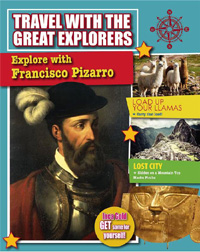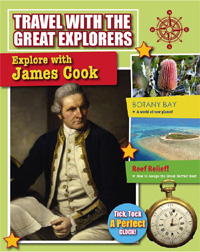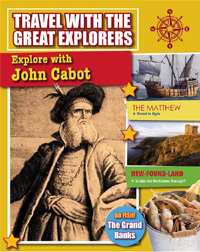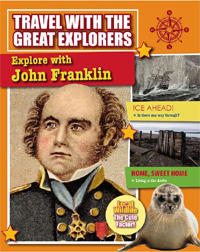| ________________
CM . . .
. Volume XXII Number 16. . . .December 18, 2015

 |
Explore with Francisco Pizarro. (Travel with the Great Explorers).
Lisa Dalrymple.
St. Catharines, ON: Crabtree, 2016.
32 pp., pbk., hc., pdf & html, $10.95 (pbk.), $21.56 (RLB).
ISBN 978-0-7787-1704-1 (pbk.), ISBN 978-0-7787-1700-3 (RLB), ISBN 978-1-4271-7704-9 (pdf), ISBN 978-1-4271-7700-1 (html).
Subject Headings:
Pizarro, Francisco, approximately 1475-1541-Juvenile literature.
Peru-Discovery and exploration-British-Juvenile literature.
Explorers-Peru-Biography-Juvenile literature.
Explorers-Spain-Biography-Juvenile literature.
Grades 4-6 / Ages 9-11.
Review by Harriet Zaidman.
**½ /4
|
| |
|
 |
Explore with James Cook. (Travel with the Great Explorers).
Lisa Dalrymple.
St. Catharines, ON: Crabtree, 2016.
32 pp., pbk., hc., pdf & html, $10.95 (pbk.), $21.56 (RLB).
ISBN 978-0-7787-1705-8 (pbk.), ISBN 978-0-7787-1701-0 (RLB), ISBN 978-1-4271-7708-7 (pdf), ISBN 978-1-4271-7701-8 (html).
Subject Headings:
Cook, James, 1728-1779-Juvenile literature.
Voyages around the world-Juvenile literature.
Explorers-Great Britain, biography-Juvenile lierature
.
Grades 4-6 / Ages 9-11.
Review by Harriet Zaidman.
**½ /4
|
| |
|
 |
Explore with John Cabot. (Travel with the Great Explorers).
Cynthia O'Brien.
St. Catharines, ON: Crabtree, 2016.
32 pp., pbk., hc., pdf & html, $10.95 (pbk.), $21.56 (RLB).
ISBN 978-0-7787-1706-5 (pbk.), ISBN 978-0-7787-1702-7 (RLB), ISBN 978-1-4271-7710-0 (pdf), ISBN 978-1-4271-7702-5 (html).
Subject Headings:
Cabot, John, -1498?-Juvenile literature.
Canada-Discovery and exploration-British-Juvenile literature.
Explorers-Great Britain-Biography-Juvenile literature.
Explorers-Canada-Biography-Juvenile literature.
Grades 4-6 / Ages 9-11.
Review by Harriet Zaidman.
**½ /4 |
| |
|
 |
Explore with John Franklin. (Travel with the Great Explorers).
Cynthia O'Brien.
St. Catharines, ON: Crabtree, 2016.
32 pp., pbk., hc., pdf & html, $10.95 (pbk.), $21.56 (RLB).
ISBN 978-0-7787-1707-2 (pbk.), ISBN 978-0-7787-1703-4 (RLB), ISBN 978-1-4271-7714-8 (pdf), ISBN 978-1-4271-7703-2 (html).
Subject Headings:
Franklin, John, Sir, 1786-1837-Juvenile literature.
Northwest Passage-Discovery and exploration-British-Juvenile literature.
Canada, Northern-Discovery and exploration-British-Juvenile literature.
Explorers-Great Britain-Biography-Juvenile literature.
Explorers-Canada-Biography-Juvenile literature.
Grades 4-6 / Ages 9-11.
Review by Harriet Zaidman.
**½ /4 |
| |
|

excerpt:
Halted by ice in Lancaster Sound, Franklin and his crew made a winter camp on Beechey Island. Living conditions would have been harsh. Two men died in January and another in April. The survivors were probably weak, but they returned to their ships in the spring and headed south. (From Explore with John Franklin.)
History becomes relevant when it is taught within the context of the present. The history of exploration is now framed as the period of contact with First Nations in different parts of the world, rather than discovery. There can be no doubt that the European explorers were brave people – setting out in wooden sailing boats with no knowledge of what they would find, experiencing severe geographic and climatic differences and encountering people with whom they had no commonality of language or culture.
But they were invaders, nevertheless, determined to set the stage for the colonization and subjugation of the “savages” whose lands they were usurping.
Crabtree’s “Travel with the Great Explorers” series tries to put a contemporary spin on history by dividing each of its books into two-page chapters and using wry titles (“This Isn’t What It Said in the Brochure!”) and subheadings splashed across the pages, with one-paragraph explanations and illustrations. The hardcover 32-page books are visually appealing and do, in general, provide a thorough overview of each explorer’s life and accomplishments, whether those accomplishments are what are now considered socially negative or positive.
But somehow the impact of European colonization is muted. Perhaps Crabtree’s view is that children won’t “get” the impact of the period of exploration, but the reality of history should not be avoided. For example, in Explore with John Cabot, the extinction of the Beothuk in Newfoundland is described: “The Beothuk moved inland, away from the sea which was a source of food. They clashed with the Europeans, and their numbers began to fall. The last known Beothuk was a woman named Shanawdithit. She died in 1829.”
More honestly, the Beothuk were driven further and further inland by British settlers who had superior technology (metal tools, traplines and guns). The Beothuk “clashed” with the settlers when they stole food and traps because they were starving; the up to 2000 Beothuk who populated Newfoundland were killed or died from European diseases until only one individual was left who could be documented.
Each book is organized well, with a table of contents at the front and a glossary, a list of recommended websites and books, a timeline and an index at the back. The standard template used in the series provides sameness for young readers; however, its structure does not lend itself to effective teaching. The “Where Are We Heading?” chapter outlines where the individual explorers travelled:
Pizarro lived for three years in Darien, a settlement founded by Balboa on the coast of what is now Colombia. In 1513, Pizarro trekked with Balboa west through the jungles of the isthmus of Panama…. (From Explore with Francisco Pizarro.)
The chapter details other locations: Tumbuz in the northwest of Peru, Cajamarca and Cuzco in the Andes, Lima, Peru. But there is no map on that page for a young reader to see where these cities are located. A map follows in the next chapter, but not everything is identified (where is Darien, and where is the isthmus of Panama?) In Explore with James Cook, the significance of the Great Barrier Reef is mentioned in “Where Are We Heading?”, but it is not pinpointed on the map in the next chapter. A blending of the two chapters, with locations more specifically identified (and perhaps embedding the pictures onto the map), would clarify the topic for children.
As in the first titles reviewed in this series, (Vol. XX Number 34. May 2, 2014), Crabtree’s editors allow unnecessary repetitions and inconsistencies in the text. In Explore with John Cabot, the Beothuk are described as using red ochre, or clay, from the ground to colour their skin, but on the next page the red ochre is described as iron oxide from clay deposits. While those may be two descriptions of the same thing, young readers may not know what iron oxide is. Why not tell them? There are other examples that should have been caught by keen editing.
Children can be entranced by history when it’s presented in an interesting, relevant way. The “Travel With the Great Explorers” series could contribute to student learning by keeping the way children learn at the top of mind, as well as contemporary interpretations of events once glorified.
Recommended.
Harriet Zaidman is a teacher-librarian in Winnipeg, MB.

To comment
on this title or this review, send mail to cm@umanitoba.ca.
Copyright © the Manitoba Library Association. Reproduction for personal
use is permitted only if this copyright notice is maintained. Any
other reproduction is prohibited without permission.
Next Review | Table of Contents For This Issue - December 18, 2015
CM Home | Back Issues
| Search
| CM Archive
| Profiles Archive
|



